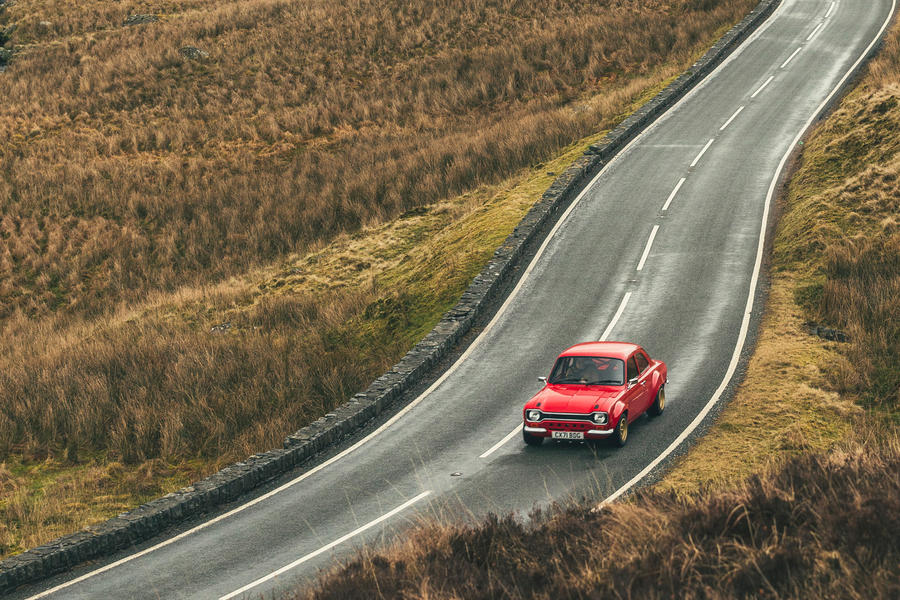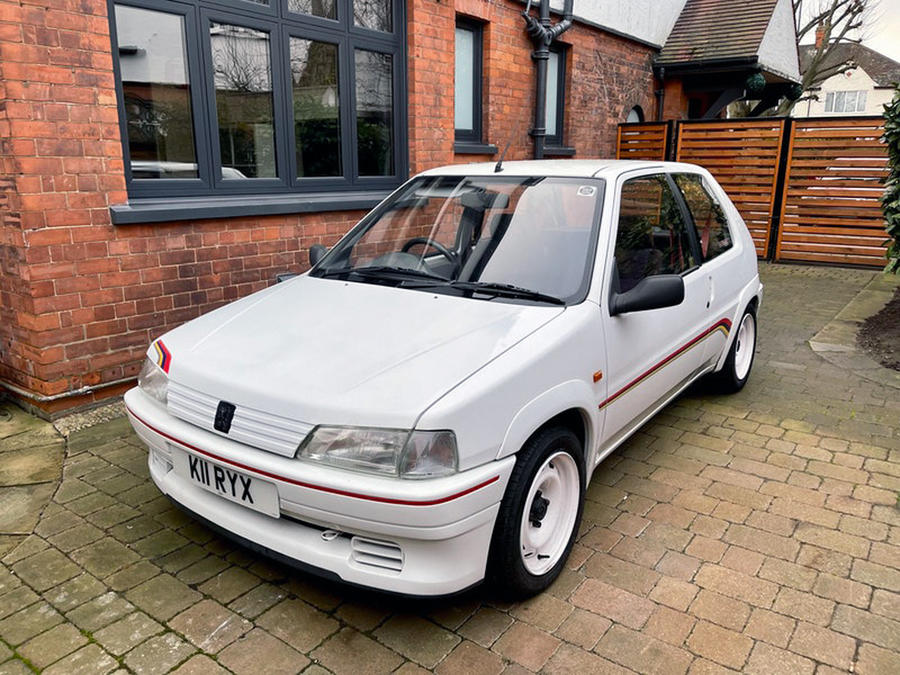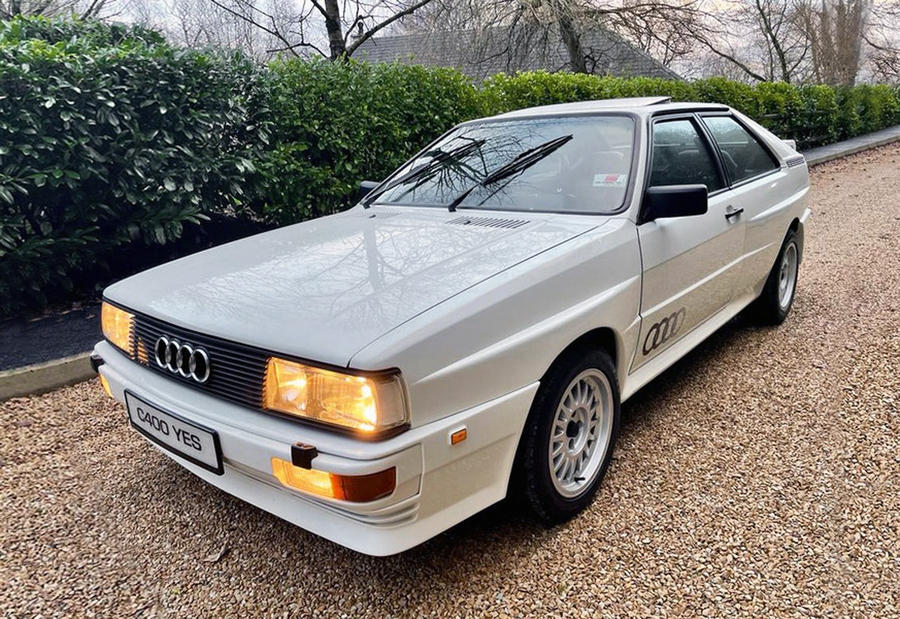A 71-plate and a lack of Ford badges give the game away
Motorsport Tools’ recreation of a famed rally weapon is as enthralling to drive as its looks suggests?
We’re up with the gods today, halfway to the top of a Welsh mountain, and we’ve got some moody, blustery weather to suit. Luckily, we’ve also got an offering of which those gods should wholeheartedly approve – and, funnily enough, it’s come along at just the right time.
Fifty years ago this year, a momentous chapter opened in the history of British motorsport. In 1972, driving a potent little saloon that had already built up a tidy little international rallying pedigree, Roger Clark and Tony Mason became the first all-British driver and co-driver pairing to win the RAC Rally for more than a decade, and they did it in a British-made Mk1 Ford Escort RS1600.
They wrote their success on stages all over Britain, of course, but some were very close to where we are now in Snowdonia: Penmachno, Coed-y-Brenin and Clocaenog – names that bring visions of blurred trees, opposite lock and flying mud and gravel flooding back from somewhere deep in the nation’s collective memory.
There would be plenty more wins like the one in 1972. The Escort’s hot streak would continue with Timo Mäkinen winning in 1973, 1974 and 1975, and then Clark again in 1976. Others among their Ford team-mates would go on to win in the following years, so that no other car but an Escort would actually claim the RAC Rally until 1980. Lesser podium finishes would be almost ten a penny.

Eight straight RAC crowns remains quite the coup: a feat of dominance no other rally car recorded before the Escorts (between Mk1 and Mk2, the car regenerating, Doctor Who-style, in 1975), and none has repeated since. It fuelled Ford’s UK-market sales performance for decades and kindled a fanatical following for the Escort among rallying competitors and fans that few other cars since have enjoyed. 1972 was, in short, the beginning of something very significant, both for British rallying in general and the Ford Escort in particular, even though it came a couple of years after Hannu Mikkola’s famous London to Mexico rally win.
And apparently it was something potent enough still to be setting hearts and wallets aflutter even now, in certain parts of our sceptred isles, and the MST Mk1 is the proof. This looks an awful lot like a brand-new, boxfresh, 1970s-era Mk1 Ford Escort world rally car that’s been in some massive zip-lock plastic bag for the past five decades. But look closely and you’ll see what it’s missing: a blue oval Ford badge on the grille, as well as any Escort model nomenclature on the bootlid.
This is not actually a Ford but a hand-built modern twin of one, if you like; a car with a new registration document and a 71-plate but made out of the exact same sheet metalwork and axles that might be used to repair or restore any ‘original’ historic Escort rally car in need of some mechanical attention in 2022. The MST Mk1 has been built to a specification devised to honour the rallying versions of the Mk1 Escort but has a body and chassis considerably strengthened and enhanced from 1970s spec, and it’s yours for a little under £100,000 before VAT – which is a bit of a snip compared with what some modern makers of ‘restomod’ vehicles are currently asking. It’s the real McCoy, as much as any new Escort could be, but it’s not made by Ford, so it can’t be badged as if it had been, and it can’t be run as a ‘historic’ rally car either.

It’s the work of Pwllheli-based Motorsport Tools Ltd, or MST for short. Having been in the business of supplying both parts and tools to the motorsport scene – and principally to the rallying fraternity – for 14 years, this firm quickly came to specialise in the support of mucky, hard-driven Ford Escort Mk1s and Mk2s. Then it built up a sufficiently extensive catalogue in order to be able to offer complete, ground-up ‘re-shell’ restorations of the cars. Then early last year, at its customers’ behest, it swallowed hard and took the next logical step by introducing a brand-new, MST-registered take on the Mk2. Its equivalent tribute to the Mk1 – our focus of attention today – came later in the year.
MST proprietor (and long-time rally driver of a Mk2 himself) Carwyn Ellis says he’s had only informal communications with Ford itself. Quite pleasingly, the gist of them is that, as long as they’re not badged as Fords or Escorts, these cars are all right by Henry. It clearly isn’t among Ford’s plans to build and sell Escort continuation cars itself, then; nor, you’d guess, is it ever likely to be.
Whether MST really has the right to make them in the first place can be debated, of course. But when the cars are built this well, frankly, you wonder how Ford could really object. The Mk1 isn’t one of those slightly awkward-looking amalgamations of modern mechanicals with older-looking body panels; it’s an Escort right down to the fine details and in pretty much everything except name.
The chassis ‘shell’ and body panels are exact matches for those of the original car, although MST’s in-house-designed panels are in fact double-skinned and seam-sealed, while the car’s chassis is strengthened in key areas. The first Mk1 demonstrator is very close to 1970s Group 4 top-level international rally specification, hence the bulging arches, extra-wide 13in Minilite wheels, fully adjustable suspension (struts at the front, a gorgeous Atlas six-link live axle at the rear and Bilstein coilovers all round) and Cosworth-designed 2.0-litre BDG racing engine. It had to look right, according to MST, and had to prove the firm was worthy of bringing such an iconic rally car back to life in the first place. Does it ever.

Assembled by Gathercole Race Engines in Peterborough, the Mk1’s engine is bigger than a period-correct Cosworth 1.7-litre BDB, but it’s still technically related. It revs to 9000rpm, it produces 250bhp in road tune (or 280bhp in competition spec) and it’s the engine used by most historic Escort rally cars at the moment. However, if you want a slightly calmer Duratec-engined Mk1, or one with a sequential gearbox and a 350bhp Millington Diamond four-pot (you madman/ woman), or one with the narrower body and skinnier wheels of a Group 2 Escort Twin Cam, well, MST will happily build you one. “The one thing we can’t do is put a Crossflow or Pinto engine in a new car, because they wouldn’t pass modern IVA certification,” says Ellis.
MST’s work on the interior is mostly intended to make the idea of driving a 1970s rally car on the road in 2022 seem a little less unhinged. Trust me, it’s never likely to seem sensible, and nor, for a moment, should it. You can choose standard seats and an uncaged chassis if you like, but MST’s demonstrator has a full cage. There are MST-branded racing buckets (which are tight around your hips), both three-point inertia-reel belts and racing harnesses, and a lovely lightweight, Alcantara Motamec steering wheel. There’s Alcantara on the door panels and headlining, too, carpets on the floor, hand-stitched leathers on the dashboard and even an aftermarket touchscreen infotainment system. Efforts have evidently been made to make this feel more like the kind of car on which you could spend a six-figure sum and end up with something that looks and feels suitably expensive.
But the Mk1 is also purposeful and authentic. The cabin offers plenty of room and decent ergonomics even for a 6ft 3in driver (you couldn’t say that about some of the Mk1’s contemporaries). The twin banks of analogue clocks, showing everything from battery voltage to oil temp, look spot on. The unmarked black plastic shift lever for the five-speed manual gearbox is wonderfully simple. And the car’s pedals are temptingly closely aligned so you can pivot perfectly off the brake and onto the accelerator during downshifts

You’ll need to, because this car demands proper driving. Not just heel-and-toe gearshifts either, but it’s to be guided with plenty of concentration, with half an eye on the topography of the road ahead as well as its direction and the other half on both the speedo and the rev counter. It’s likely to sort out wealthy supercar owners who fancy the idea of owning and driving something more old school from those who actually like the reality of it, I’d say.
It’s earplug-territory noisy even if you’re not planning on using more than the first half of the rev range. It’s physical, too, heavy and a little snatchy of clutch action, superbly mechanical and honest in its shift quality. It demands plenty of effort on the brake pedal as well, and it’s heavy through the rapier-quick steering at manoeuvring speeds (MST actually fits electromechanical power assistance, but much of the time you wouldn’t know it). It’s nicely animated over an interesting road surface: not overly firm or bristling with intent but surprisingly supple and not a little bit charming as it breathes and shoulders its way through twists and over bumps.
This car is not backwards in coming forwards; it’s expressive in every way. The throttle response is absolutely pin-sharp – so much so that rolling onto the right-hand pedal when you’re deep into the brakes without sending the revs too high demands plenty of practice.

The way it sounds under load, and then delivers its power? Every bit as epic as your memories, or all of those rally archive YouTube videos, might lead you to hope. There’s a dark, almost medieval hammer-and-tongs bark to the engine even at middling revs, and it only hardens as the tacho needle rises. Be warned: if you’ve never heard a Cosworth BD engine like it, it could put your affection for modern Honda VTECs and their ilk into pretty stark perspective.
The motor doesn’t give the Mk1 frantic performance, but with everything the car gives you to manage and process – from preventing the offside front wheel from migrating across the crown of the road so that you stay true to your intended line, to keeping big throttle applications and mid-corner bumps (which can travel across that rear axle even from the unloaded side) at a respectful distance from each other – you honestly wouldn’t want it much quicker. And certainly not as it howls past 5500rpm, and then on beyond 7000, with another level of gathering force and banshee anger coming on stream at each point.
You need to let the ringing in your head subside before you can have considered thoughts about this car. If it were mine, I’d have it with that unforgettable BD engine, definitely; but with a slightly less wide and less grippy wheel and tyre specification than this demonstrator’s Minilite 13s and Kumho track-day tyres, which do make the Mk1 a bit sensitive to camber and fine steering input. The car doesn’t look quite right with a wide body, a bigger-diameter rim and a skinnier-section tyre, apparently, so I’d probably have to go with the standard arches, too.

But with just the right combination of grip level, control weight and feedback, and with the first-rate body control and chassis balance the Mk1 already demonstrates, this could be an incredible road car. As it is, it’s already a very special one: equally spectacular in both how it looks and how it sounds; supremely raw, evocative, analogue and absorbing in how it drives, and ready for a great deal more than just road use, if you’re so inclined.
In the right company, it’s also quite the big deal, I must admit. This may be of no interest whatsoever to its would-be owners, or it may be at the heart of the car’s appeal, but if you want to win friends and influence passers-by amid the mountains and forests of North Wales, don’t go there in a German sports car or an Italian supercar. The locals see plenty of those. No, take them a locally made rallying icon with a blood-and-thunder Cosworth engine and, even as an interloping Englishman, you’ll be welcomed like a returning king.
The Escort Mk1’s rallying CV

The Mk1 Escort gained notoriety for its rally successes, although in the main it competed before both manufacturer and driver championship points started to be awarded like they are today.
The car’s successes at the RAC Rally were mirrored by similar victories on the 1000 Lakes Rally, where Timo Mäkinen’s home advantage paid dividends. There were early successes for the car elsewhere in the 1960s, as well as Hannu Mikkola’s famous London to Mexico World Cup Rally event win, for which the Escort Mexico road car was named.
- Acropolis Rally, 1968
- 1000 Lakes Rally, Finland, 1968, 1973, 1974
- Tulip Rally, 1969
- Austrian Alpine Rally, 1969
- Vltava Rally, 1969
- London to Mexico World Cup Rally, 1970
- Safari Rally 1972
- RAC Rally, 1972, 1973, 1974
Road-legal rallying alternatives

Citroen Saxo, £3000: This Citroën Saxo has been comprehensively overhauled specifically for rallying, gaining Bilstein suspension, a hydraulic handbrake, a 1.1 gearbox with Tran-X limited-slip differential, uprated front brakes and an eight-point bolt-in roll-cage. The previous owner has spared no expense, even adding a fibreglass bonnet and Perspex windows. Yours for £3000.

Peugeot 106 Rallye, £7450: This Phase 1 Peugeot 106 Rallye is powered by the French firm’s punchy 1.3-litre engine, with 100bhp at 7200rpm. The model’s strengths were its chassis and steering, and a 826kg kerb weight meant few hot hatches topped it in the turns. This one has several new parts installed and an extensive history but needs a quick repaint.

Audi Quattro, £48,000: The four-wheel-drive Audi Quattro is a rally icon that took almost every gong going, including two manufacturer world titles. A 2.0-litre turbocharged engine makes 197bhp, giving a 0-62mph time of 7.1 sec. This example has covered 90,000 miles and has an extensive service history and immaculate bodywork.

MG Metro 6R4, £450,000: The MG Metro 6R4 was designed by Williams and packs four-wheel drive and a bespoke 3.0-litre V6 engine that makes 410bhp. It was said to be the first engine designed specifically for rallying. We found one for £450,000; it’s one of just nine works cars produced and was used as a recce car for rally driver Tony Pond.
Factfile
Price From £114,000 Engine 4 cyls in line, 1975cc, petrol Power 250bhp at 8000rpm Torque 180lb ft at 6500rpm Gearbox 5-spd manual, RWD Kerb weight na 0-62mph 5.0sec (est) Top speed 130mph (est) Economy na CO2, tax band na Rivals Alfaholics GTA-R, Volvo P1800 Cyan Racing
Source: Autocar
